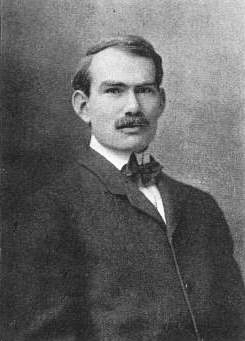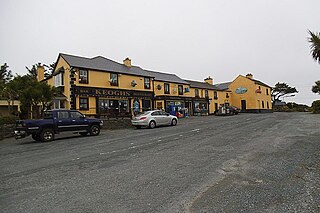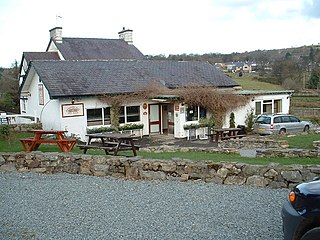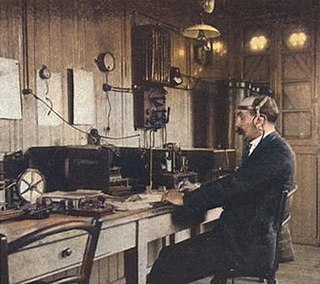Related Research Articles

Guglielmo Giovanni Maria Marconi, 1st Marquis of Marconi GCVO was an Italian inventor and electrical engineer, known for his creation of a practical radio wave–based wireless telegraph system. This led to Marconi's being credited as the inventor of radio, and he shared the 1909 Nobel Prize in Physics with Karl Ferdinand Braun "in recognition of their contributions to the development of wireless telegraphy".

Karl Ferdinand Braun was a German electrical engineer, inventor, physicist and Nobel laureate in physics. Braun contributed significantly to the development of radio and television technology and built the first semiconductor. He shared the 1909 Nobel Prize in Physics with Guglielmo Marconi "for their contributions to the development of wireless telegraphy", was a founder of Telefunken, one of the pioneering communications and television companies, and has been both called the "father of television", "great grandfather of every semiconductor ever manufactured" and the co-father of the radio telegraphy, together with Marconi.
The early history of radio is the history of technology that produces and uses radio instruments that use radio waves. Within the timeline of radio, many people contributed theory and inventions in what became radio. Radio development began as "wireless telegraphy". Later radio history increasingly involves matters of broadcasting.

Wireless telegraphy or radiotelegraphy is transmission of text messages by radio waves, analogous to electrical telegraphy using cables. Before about 1910, the term wireless telegraphy was also used for other experimental technologies for transmitting telegraph signals without wires. In radiotelegraphy, information is transmitted by pulses of radio waves of two different lengths called "dots" and "dashes", which spell out text messages, usually in Morse code. In a manual system, the sending operator taps on a switch called a telegraph key which turns the transmitter on and off, producing the pulses of radio waves. At the receiver the pulses are audible in the receiver's speaker as beeps, which are translated back to text by an operator who knows Morse code.
The British Broadcasting Company Limited (BBC) was a short-lived British commercial broadcasting company formed on 18 October 1922 by British and American electrical companies doing business in the United Kingdom. Licensed by the British General Post Office, its original office was located on the second floor of Magnet House, the GEC buildings in London and consisted of a room and a small antechamber.

Lee de Forest was an American inventor, electrical engineer and an early pioneer in electronics of fundamental importance. He invented the first practical electronic amplifier, the three-element "Audion" triode vacuum tube in 1906. This helped start the Electronic Age, and enabled the development of the electronic oscillator. These made radio broadcasting and long distance telephone lines possible, and led to the development of talking motion pictures, among countless other applications.

Clifden is a coastal town in County Galway, Ireland, in the region of Connemara, located on the Owenglin River where it flows into Clifden Bay. As the largest town in the region, it is often referred to as "the Capital of Connemara". Frequented by tourists, Clifden is linked to Galway city by the N59.
The Marconi Company was a British telecommunications and engineering company that did business under that name from 1963 to 1987. Its roots were in the Wireless Telegraph & Signal Company founded by Italian inventor Guglielmo Marconi in 1897, which underwent several changes in name after mergers and acquisitions. The company was a pioneer of wireless long distance communication and mass media broadcasting, eventually becoming one of the UK's most successful manufacturing companies. In 1999, its defence equipment manufacturing division, Marconi Electronic Systems, merged with British Aerospace (BAe) to form BAE Systems. In 2006, financial difficulties led to the collapse of the remaining company, with the bulk of the business acquired by the Swedish telecommunications company, Ericsson.

Ballyconneely is a village and small ribbon development in west Connemara, County Galway Ireland.

Letterfrack or Letterfrac is a small village in the Connemara area of County Galway, Ireland. It was founded by Quakers in the mid-19th century. The village is south-east of Renvyle peninsula and 15 kilometres north-east of Clifden on Barnaderg Bay and lies at the head of Ballinakill harbour. Letterfrack contains the visitors centre for Connemara National Park.

Waunfawr is a village and community, 6 kilometres (3.7 mi) SE of Caernarfon, near the Snowdonia National Park, Gwynedd, in Wales.

The Marconi National Historic Site and the Marconi Wireless Station National Historic Site are two National Historic Sites located on Cape Breton Island, Nova Scotia. Both sites commemorate the efforts of Guglielmo Marconi to transmit transatlantic radio signals between North America and Europe in the first decade of the 20th century. The two sites are located within approximately 8 kilometres (5.0 mi) of one another, and are connected by the Marconi Trail.

The invention of radio communication was preceded by many decades of establishing theoretical underpinnings, discovery and experimental investigation of radio waves, and engineering and technical developments related to their transmission and detection. These developments allowed Guglielmo Marconi to turn radio waves into a wireless communication system.
The timeline of radio lists within the history of radio, the technology and events that produced instruments that use radio waves and activities that people undertook. Later, the history is dominated by programming and contents, which is closer to general history.
1922 in radio details the internationally significant events in radio broadcasting for the year 1922.
The United Wireless Telegraph Company was the largest radio communications firm in the United States, from its late-1906 formation until its bankruptcy and takeover by Marconi interests in mid-1912. At the time of its demise, the company was operating around 70 land and 400 shipboard radiotelegraph installations — by far the most in the U.S. However, the firm's management had been substantially more interested in fraudulent stock promotion schemes than in ongoing operations or technical development. United Wireless' shutdown, following federal mail fraud prosecution, was hailed for eliminating one of the largest financial frauds of the period. However, its disappearance also left the U.S. radio industry largely under foreign influence, dominated by the British-controlled Marconi Wireless Telegraph Company of America.

Captain Henry Joseph Round was an English engineer and one of the early pioneers of radio. He was the first to report the observation of electroluminescence from a solid state diode, leading to the discovery of the light-emitting diode. He was a personal assistant to Guglielmo Marconi.

The Marconi Wireless Telegraph Company of America was incorporated in 1899. It was established as a subsidiary of the British Marconi Company and held the U.S. and Cuban rights to Guglielmo Marconi's radio patents. American Marconi initially primarily operated high-powered land and transatlantic shipboard stations. In 1912, it acquired the extensive assets of the bankrupt United Wireless Telegraph Company, becoming the dominant radio communications provider in the United States.

The Marconi Railway was a 1+1⁄2 miles (2.4 km) long narrow gauge railway with a gauge of 2 feet (610 mm) at the Marconi Wireless Station near Clifden in the Irish County Galway.
References
- ↑ "The Clifden Station of the Marconi Wireless Telegraph System". Scientific American . 1907-11-23.
- ↑ "Second Test of the Marconi Over-Ocean Wireless System Proved Entirely Successful". Sydney Daily Post. 1907-10-24. Archived from the original on 2013-10-19. Retrieved 2019-10-15.